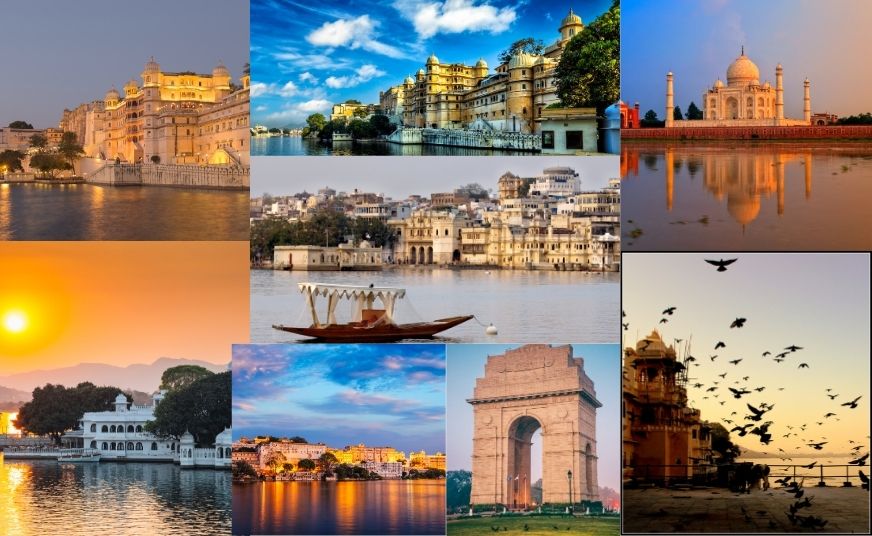Overview
Take advantage of our Golden Triangle Tour with Udaipur to experience India's rich cultural and royal legacy. The well thought-out schedule will show you the famous forts, palaces, monuments, and other architectural marvels in Delhi, Jaipur, Agra, and Udaipur—the three greatest cities in India. See amusement parks, gardens, temples, monuments, museums, planetariums, and much more. Take part in a variety of thrilling activities while visiting Jaipur, such as riding an elephant and shopping in the local marketplaces.
Thus, arrange a Golden Triangle tour that includes Udaipur and set out on an adventure of a lifetime to discover India's rich cultural legacy. Benefit from first-rate amenities like meals, sightseeing tours, guided transfers, and cozy lodging.
Please take note that this is merely a recommended itinerary that shows what might be feasible. To customize your Golden Triangle trip with Udaipur and create a memorable India tour, get in touch with us.
Highlights
- Discover Delhi's well-known sights.
- Enjoy a sightseeing tour in Agra.
- Gaze in the Taj Mahal at dawn.
- A visit to Fatehpur Sikri for the day
- A visit to Fatehpur Sikri for the day
- Tour of Jaipur's sites
- A ride on an elephant to Amber Fort
- Have fun shopping in Jaipur.
- A tour of Udaipur with a guide
Itinerary
Day 1 Delhi arrival
The vacation to the Golden Triangle with Udaipur begins with a cordial
welcome from our team members in Delhi, followed by a hotel transfer with assistance. A
visit to Delhi, the nation's capital, introduces visitors to the blend of traditional
and contemporary Indian culture. Delhi has entered a period of change as a result of the
global technology boom, where ancient culture coexists with modern practices.
You are going to Red Fort, also called the Lal Quila, which is closed on Mondays. The
foundation was established by the Mughal Emperor Shah Jahan, and it took nine arduous
years to build this stronghold. The fort features two major gates and is constructed of
red sandstone. Lal Quila serves as a reminder of the Mughal era's splendor.
On top of Kalkaji Hill is the Bahai Temple. Because of its unique lotus-shaped marble
design, it is also known as "The Lotus Temple" (Monday Closed).
Travel by the India Gate, which honors the 90,000 Indian Army troops who died defending
the President's House and the Indian Empire.
Spend the night.
Day 2: Local Sightseeing in Delhi
After breakfast, take a drive to explore New Delhi's local sights.
Mahatma Gandhi's memorial, Raj Ghat. A fitting homage to a modest man who transformed
the world using only the power of ideas, the shrine is a straightforward black stone
building with an eternal flame blazing at one end.
Red Fort is roughly 500 meters from Jama Masjid. Shah Jahan constructed this, India's
largest mosque, in the sixteenth century. It is exquisitely constructed from sandstone
and white marble. Relics are inscribed on the gates of this mosque, which can
accommodate up to 25,000 worshippers.
The Qutub Minar is a superb illustration of Afghan architecture. stands tall with a
brick minaret that is 73 meters high. The five-story building, which was constructed by
Qutub-ud-din Aibak, is adorned with numerous chiseled carvings and texts.
The Tomb of Humayun The Humayun's Tomb, a UNESCO World Heritage Site, was constructed in
1570 by Humayun's wife, Haji Begum. The Taj Mahal's design is unquestionably one of the
most magnificent examples of Mughal architecture.
Spend the night.
Day 3: Delhi to Agra
A drive from Delhi to Agra; after you reach Agra, check into a hotel that
you have reserved in advance. After a short period of rest, you will be given a tour of
the old city of Agra. A massive number of travelers from all over the world visit the
Taj.
Taj Mahal: Every Friday, it is closed. This architectural marvel, which is always the
main reason visitors come to Agra, doesn't need much explanation. The Taj Mahal, a white
marble monument honoring Shah Jahan's lovely wife, Mumtaz Mahal, was constructed by him.
This monument was conceived and created by Ustad Isa, a Persian architect, and took 22
years to finish. In addition to its exquisite symmetry and balance, the Taj is renowned
for its exquisite domes, finely carved screens, and some of the most exquisite inlay
work ever seen.
AGRA FORT: A four-square formal garden called Chahar-Bagh encircles the red sandstone
building. Mostly made of red sandstone, the fort was constructed in 1565 AD by the
renowned Mughal emperor Akbar. The stunning Pearl Mosque, a popular tourist destination,
is nestled inside. Almost in the center of the town, it is situated on the bend of the
Yamuna River. Between 1563 and 1573, Akbar constructed it as his castle in the most
exquisite architectural style. It features red sandstone walls, a moat, and towering
gates.
The inside of the ITMAD-UD-ULLAH, also known as the Baby Taj, is thought to be superior
to the Taj when we visit the Agra Fort. Itmad-Ud-Daulah's Tomb, one of the most
exquisite Mughal monuments, was constructed for her father in 1628 by Nur Jahan, the
Empress of Jehangir. The tomb is the final resting place of Itmad-Ud-Daulah, a prominent
figure in the Mughal Court whose life is fascinating.
Stay overnight in Agra.
Day 4: Agra to Jaipur (about 245 km/four hours)
The travel to the pink city of Rajashtan, Jaipur, via Fatehpur Sikri,
begins the following morning. The district of Agra includes this city. The Sikriwal
Rajput Maharana Sangram Singh was essentially responsible for its construction.
Infatuated with this city's splendor, Akbar launched seven attacks before capturing it
on his final try. As a result, the Rajputs were forced to abandon it, and it has since
been known as Fatehpur (conquered) Sikri. In this Uttar Pradesh city, the essence of
both Rajjput and Mughal culture can be seen.
The ship then heads for Jaipur, the pink city of Rajasthan, after touring the splendor
of Fatehpur Sikri. Jaipur is home to numerous sites that depict the tale of the valiant
Rajputs of this desert's past. This city is adorned with numerous historical gems,
including the City Palace, Hawa Mahal, Jal Mahal, Jaigarh Fort, Amer, and Sish Mahal.
The blending of traditional and modern culture in Jaipur has made it one of the top
travel destinations for people from all over the world.
Once you arrive in Jaipur, you will be checked into a hotel for the night.
Day 5: Sightseeing in Jaipur
The first structure you will see after breakfast on your tour of forts and
palaces today is the Hawa Mahal.
HAWA MAHAL: One of Jaipur's most notable landmarks is the "Palace of Winds" with its
ornate exterior. Their five-story buildings are made of pink-plastered sandstone that is
covered with intricate balconies and delicate trelliswork. The palace features 953
windows and niches. Pratap Singh constructed the Mahal in 1799 as a regal grandstand for
the women of the palace.
At Amber Fort, you will now travel to enjoy the most popular tourist activity, the
elephant ride, which may be reserved for an extra fee. Amber Palace is a must-visit
location in Jaipur, set amid the gorgeous and rugged Aravalli Hills. Mirja Raja Jai
Singh finished this palace after Raja Man Singh I set the foundation stone.
JAL MAHAL: The Water Palace, also known as Jal Mahal, is a traditional Rajputana
architectural structure situated in the center of Man Sagar Lake. Four stories of the
five-story structure are submerged when the lake fills up.
CITY PALACE: Covering one-seventh of the walled city, the City Palace is a charming
fusion of Mughal and traditional Rajasthani architecture. The City Palace Museum, the
Chandra Mahal, and the Shri Govind Dev Temple are all located there.
The largest and best-preserved of the five observatories constructed by Jai Singh II
across the nation is the Jantar Mantar. The large astronomical instruments in this
observatory are still in service today.
Now, if you have the time, you can both enjoy shopping independently in the nearby
market. Jaipur offers excellent shopping, especially for wooden handicrafts, carpets,
silk, saris, pottery, tie-dye materials, and jewelry made of gold and silver.
or go to
GOVIND DEV JI TEMPLE: Located in the City Palace complex, Jaipur is home to a famous
Vaishnava temple called Govindji temple or Govind Dev Ji temple.
Return to the hotel to spend the night there.
Day 6: Journey from Jaipur to Udaipur (approximately 430 km/06 hours)
On the way to Udaipur after breakfast.
As soon as you get to Lake City, finish the hotel check-in procedures. Once you've had a
chance to clean yourself, go to the "Jewel of Mewar," one of the most gorgeous cities.
With three connected lakes—Pichola Lake, Swaroop Sagar Lake, and Fateh Sagar
Lake—Udaipur is one of the most romantic cities in India and a popular tourist
destination. Spend the night somewhere.
Day 7: Touring Udaipur
At the hotel, breakfast will be provided.
Take a sightseeing tour of Udaipur, beginning at the City Palace.
The enormous City Palace, which has a stunning view of Lake Pichola, is a prime example
of Rajput architecture. Today, a portion of the city palace is a museum. Dark, steep,
and narrow staircases lead through a labyrinth of royal apartments and courtyards behind
the palace's defended walls. All around, there are stunningly detailed miniatures,
antiques, and paintings on exhibit. Notable features include a courtyard with lots of
shade trees on the terrace of Amar Vilas and stunning mosaics of peacocks in More Mahal.
In the middle of the 18th century, Maharana Sangram Singh constructed Saheliyon Ki Bari,
often known as the "Garden of the Maidens," on the shores of Fateh Sagar Lake. Fountains
with spouts set inside the trunks of massive stone elephants adorn the garden's verdant
lawns. Only water pressure can regulate the flow of water. There are no pumps used. One
noteworthy example is an intriguing sound design attempt from the Middle Ages. Carefully
chosen large-leafed plants in a remote area of the garden muffle the sound of water
cascading on stones, giving the impression that you are in a vast tropical forest while
it is pouring rain.
The city's heart is home to the spectacular 17th-century Jagdish Temple, a superb
illustration of Indo-Aryan architecture. A massive picture of Lord Vishnu made of black
stone serves as the focal point. The tower and the temple's outside walls are adorned
with intricate carvings of Vishnu and events from Krishna's life.
Go ahead and take the evening motor launch trip on Lake Pichola's serene waters for an
extra fee.
You will stay overnight in Udaipur.
Day 8: Leaving Udaipur
In the morning, you are given a delicious breakfast before traveling to Udaipur Airport to board a flight to your next location.
- Destination
- Pick Up From
- Drop Off At
- Vehicle
- Language
- Currency Used
- Destination
- Delhi, Agra, Jaipur and Udaipur
- Delhi, India
- Delhi, India
- Car
- English and Hindi
- INR
- 4 Cities
Services included
- 7 nights hotel room with two people sharing
- Everyday breakfast buffet
- Tour Guide Services.
- Bottled mineral water
Services Excluded
- Insurance
- Any personal costs
- Driver and guide tips
- Dining at a restaurant or hotel for lunch and dinner
- Dining at a restaurant or hotel for lunch and dinner










